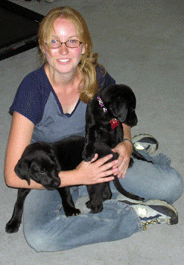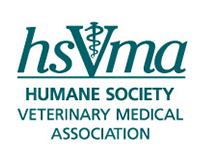Vet Student Instrumental in Ending Terminal SurgeriesBy Susan Krebsbach, DVM As I listened to Sarah Gordon share her experiences recently, I relived some of the emotional turmoil that I experienced two decades earlier when I fought for an "alternative" curriculum that did not involve killing animals at The Ohio State University College of Veterinary Medicine. It takes strong ethics and courage to go against the status quo. Sarah Gordon has both. When she graduates this May from Oklahoma State University (OSU) Center for Veterinary Health Sciences, Sarah will not only have succeeded in developing an alternative curriculum for herself—she has helped prompt OSU to eliminate terminal surgeries from the core curriculum altogether. An Uphill Battle Sarah Gordon, veterinary student at OSU and HSVMA student member, played a pivotal role in changing the surgery curriculum at her school. Sarah's veterinary education has not been without controversy. Informed prior to admission that students who objected to performing "terminal surgeries"— procedures in which animals used in training are euthanized rather than recovered after surgery—would have an alternative at a different veterinary school, Sarah tried to pursue the option in her second year. Upon learning that the option no longer existed, Sarah campaigned to persuade the school to offer her some alternative that would allow her to learn surgery without violating her ethical beliefs. She solicited support from several sources, including the Association of Veterinarians for Animal Rights (AVAR), an organization that has since been incorporated into the Humane Society Veterinary Medical Association (HSVMA). After receiving a letter from AVAR on humane alternatives, Sarah believed that OSU became more receptive and before Sarah's third year, the school had developed a program involving procedure-based surgeries on cadavers and additional rotations in anesthesia and surgery. Though Sarah herself was saved the anguish of euthanizing a healthy patient, she recalls seeing classmates cry over this experience. It was time for a change at OSU. Humane AlternativesTwenty years ago, veterinary students like myself were promoting humane surgical training and arguing that medical and surgical competence could be gained without harming animals. Today, though animals are still killed in veterinary training, it is becoming more common to provide an alternative. A survey conducted in 2007 of the 28 U.S. veterinary schools found that at least half of the schools had dropped terminal surgeries from their required curriculum. How are vet schools implementing humane veterinary training? In addition to using technical alternatives such as simulators, virtual reality and life-like models, schools are still using animals, but in ways that benefit the animals while providing training opportunities for students. Today, the majority of veterinary schools have established some type of partnership with animal rescue organizations to provide spay and neuter services for homeless animals. These cats and dogs are sterilized by the students—with faculty supervision—and then returned for adoption. This gives the students training in surgical, anesthetic and recovery skills and gives the animals a better chance of finding a home. Making StridesDue in large part to the courageous efforts of Sarah Gordon, change is now happening at OSU. Pressure stemming from media coverage of Madeline Pickens' recent announcement that she was withdrawing a $5 million donation from the OSU veterinary school due to animal use practices she described as "barbaric" has helped as well. In a recent communication with students, Michael Lorenz, Dean of the OSU Center for Veterinary Health Sciences, announced, "All live animal surgery will be survival and we will utilize dogs from animal shelters for spay and neuter procedures. Animals will be returned to the shelters for adoption." HSVMA, the veterinary division of the Humane Society of the United States, applauds this decision. In addition, it is our understanding according to published reports that, as a result of this policy change, the school will no longer be using the services of Class B dealers and animals seized from shelters. This also is a welcome development. Sarah is thrilled about this change and feels that it will be better for the students and OSU—and of course, the animals. As she prepares to graduate, Sarah shared with me how proud she is to be a part of the OSU veterinary program, having the privilege of learning from an amazing faculty and experiencing the comradeship she feels with her classmates. Sarah has much to celebrate: in addition to preparing to enter the field of her dreams, her actions have fulfilled a dream many have shared for years. And she has already helped changed the world for animals—for the better. Please visit the HSVMA Resources page for information on establishing alternative teaching solutions at veterinary schools. Dr. Susan Krebsbach is a Veterinary Consultant for HSVMA |
